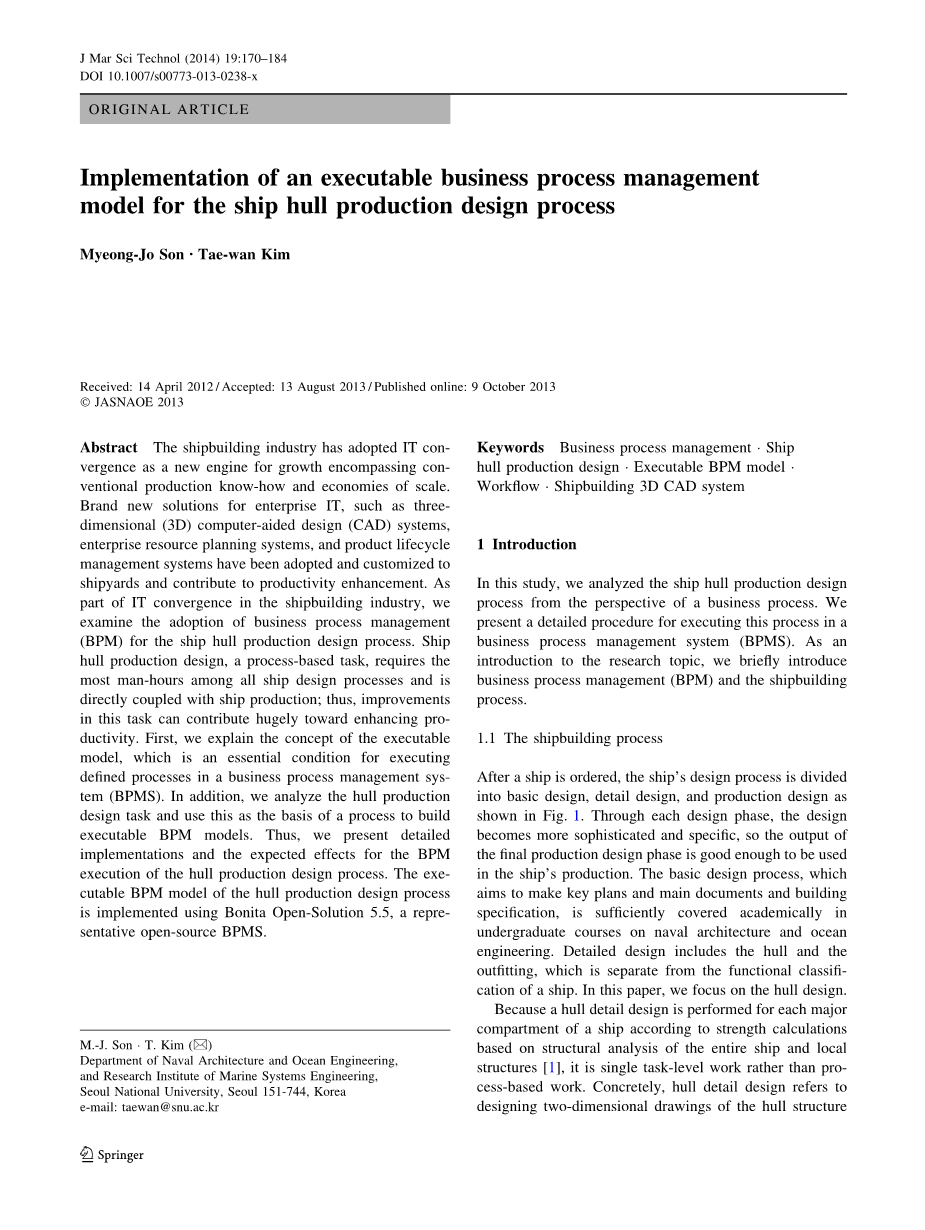

英语原文共 15 页
Implementation of an executable business process management model for the ship hull production design process船体生产设计过程里实施可执行的业务流程管理模型
摘要
The shipbuilding industry has adopted IT convergence as a new engine for growth encompassing conventional production know-how and economies of scale. Brand new solutions for enterprise IT, such as three-dimensional (3D) computer-aided design (CAD) systems, enterprise resource planning systems, and product lifecycle management systems have been adopted and customized to shipyards and contribute to productivity enhancement. As part of IT convergence in the shipbuilding industry, we examine the adoption of business process management (BPM) for the ship hull production design process. Ship hull production design, a process-based task, requires the most man-hours among all ship design processes and is directly coupled with ship production; thus, improvements in this task can contribute hugely toward enhancing productivity. First, we explain the concept of the executable model, which is an essential condition for executing defined processes in a business process management system (BPMS). In addition, we analyze the hull production design task and use this as the basis of a process to build executable BPM models. Thus, we present detailed implementations and the expected effects for the BPM execution of the hull production design process. The executable BPM model of the hull production design process is implemented using Bonita Open-Solution 5.5, a representative open-source BPMS.
造船业采用IT融合作为增长的新引擎,包括传统的生产技术和规模经济。企业IT的全新解决方案,如三维(3D)计算机辅助设计(CAD)系统,企业资源规划系统和产品生命周期管理系统已被采用并为船厂定制,有助于提高生产力。作为造船业IT融合的一部分,我们研究了船体生产设计过程中业务流程管理(BPM)的采用。船体生产设计是一项基于过程的任务,在所有船舶设计过程中需要最多的工时,并且直接与船舶生产相结合;因此,这项任务的改进可以极大地提高生产力。首先,我们解释可执行模型的概念,这是在业务流程管理系统(BPMS)中执行已定义流程的基本条件。此外,我们分析船体生产设计任务,并将其作为构建可执行BPM模型的流程的基础。因此,我们提出了船体生产设计过程的BPM执行的详细实施和预期效果。船体生产设计过程的可执行BPM模型使用代表性的开源BPMS Bonita Open-Solution 5.5实现。
1简介
In this study, we analyzed the ship hull production design process from the perspective of a business process. We present a detailed procedure for executing this process in a business process management system (BPMS). As an introduction to the research topic, we briefly introduce business process management (BPM) and the shipbuilding process.
在这项研究中,我们从业务流程的角度分析了船体生产设计过程。 我们提供了在业务流程管理系统(BPMS)中执行此过程的详细过程。 作为研究课题的介绍,我们简要介绍了业务流程管理(BPM)和造船过程。
1.1造船过程
After a ship is ordered, the shiprsquo;s design process is divided into basic design, detail design, and production design as shown in Fig. 1. Through each design phase, the design becomes more sophisticated and specific, so the output of the final production design phase is good enough to be used in the shiprsquo;s production. The basic design process, which aims to make key plans and main documents and building specification, is sufficiently covered academically in undergraduate courses on naval architecture and ocean engineering. Detailed design includes the hull and the outfitting, which is separate from the functional classification of a ship. In this paper, we focus on the hull design.
订购船舶后,船舶的设计过程分为基本设计,详细设计和生产设计,如图1所示。通过每个设计阶段,设计变得更加精密和具体,因此最终生产设计的输出 阶段足以用于船舶的生产。 旨在制定关键计划和主要文件以及建筑规范的基本设计过程在学术上充分涵盖了船舶结构和海洋工程的本科课程。 详细设计包括船体和舾装,它与船舶的功能分类是分开的。 在本文中,我们专注于船体设计。
造船过程和船体生产设计过程
Because a hull detail design is performed for each major compartment of a ship according to strength calculations based on structural analysis of the entire ship and local structures [1], it is single task-level work rather than process-based work. Concretely, hull detail design refers to designing two-dimensional drawings of the hull structure using predefined symbols and lines for each compartment; depending on the type of ship, these compartments have structural consistency or are separated by functionality. These compartments can be parts of a ship, such as the engine room, main deck, bow, or stern, or structural modules with special functions, such as the shaft strut, funnel, or sea chest. The resulting construction of a ship hull detail design is based on key plans such as the general construction, general arrangement, and mid-ship section that are outputs of basic design. The construction includes details such as the position and specifications of stiffeners, end cut method, bracket, and collar plate for a cutting hole to ensure sufficient structural strength. Depending on the type of ship, there may be 20–50 construction tasks, but they are not issued and completed simultaneously. The construction is begun and issued sequentially according to the manpower capacity of the hull structural design team or to secure structural consistency between compartments. The construction that is done on the basis of the hull detail design cannot be completed only from the design and structural analysis of the corresponding hull structure. It also requires confirmation from relevant co-workers in the outfitting design team, review from the design part manager, and approval from the ship owner. Therefore, depending on the work difficulty and the correlation with the relevant team, this process may take 1 month to 1 year to complete. The construction is in the form of a large print drawing, such as A0 or A1 size, and may exceed 7 m in length in certain cases.
因为根据整个船舶和所在结构的结构分析[1],根据强度计算对船舶的每个主要舱室进行船体细节设计[1],它是单任务级工作而不是基于过程的工作。具体地,船体细节设计指的是使用每个隔间的预定义符号和线来设计船体结构的二维图;根据船舶的类型,这些舱室具有结构一致性或由功能分开。这些隔间可以是船的一部分,例如发动机室,主甲板,船首或船尾,或具有特殊功能的结构模块,例如竖井支柱,漏斗或海水箱。由此产生的船体细节设计结构基于关键计划,例如基本设计输出的一般结构,总布置和中间部分。该结构包括诸如加强筋的位置和规格,端部切割方法,支架和用于切割孔的套环板的细节,以确保足够的结构强度。根据船舶的类型,可能有20-50个施工任务,但不会同时发布和完成。根据船体结构设计团队的人力资源开始并按顺序发布施工,或确保隔间之间的结构一致性。基于船体细节设计完成的构造不能仅通过相应船体结构的设计和结构分析来完成。它还需要out装设计团队中的相关同事确认,设计部门经理审核以及船东的批准。因此,根据工作难度和与相关团队的相关性,此过程可能需要1个月到1年才能完成。该结构采用大型印刷图形,例如A0或A1尺寸,在某些情况下长度可超过7米。
Hull production design is a final-stage design and acts as a bridge between design and production. Hull production design is closely related to the facilities a
资料编号:[5662]
以上是毕业论文外文翻译,课题毕业论文、任务书、文献综述、开题报告、程序设计、图纸设计等资料可联系客服协助查找。


